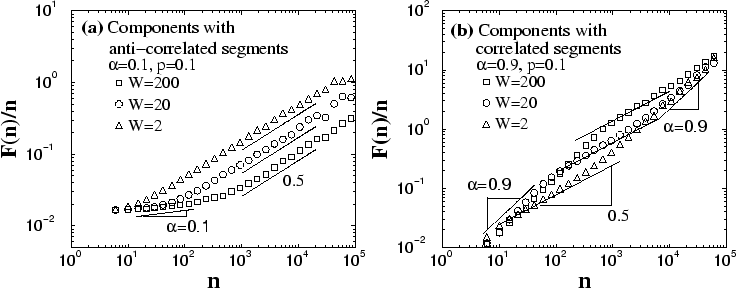First, we consider components containing segments with anti-correlations. For a fixed value of the fraction
Next, we study how the scaling behavior of the components depends on the size
of the segments ![]() .
.
First, we consider components containing segments with
anti-correlations. For a fixed value of the fraction ![]() of the segments, we
study how
of the segments, we
study how ![]() changes with
changes with ![]() . At small scales, we observe a behavior
with a slope similar to the one for a stationary signal
. At small scales, we observe a behavior
with a slope similar to the one for a stationary signal ![]() with identical
anti-correlations [Fig. 8(a)]. At large scales, we observe a
crossover to random behavior (exponent
with identical
anti-correlations [Fig. 8(a)]. At large scales, we observe a
crossover to random behavior (exponent ![]() ) with an increasing
crossover scale when
) with an increasing
crossover scale when ![]() increases. At large scales,
we also find a vertical shift with increasing values for
increases. At large scales,
we also find a vertical shift with increasing values for ![]() when
when ![]() decreases [Fig. 8(a)]. Moreover, we find that there is an
equidistant vertical shift in
decreases [Fig. 8(a)]. Moreover, we find that there is an
equidistant vertical shift in ![]() when
when ![]() decreases by a factor of
ten, suggesting a power-law relation between
decreases by a factor of
ten, suggesting a power-law relation between
![]() and
and ![]() at large scales.
at large scales.
 |
For components containing correlated segments with a fixed value of the
fraction ![]() we find that in the intermediate scale regime, the segment size
we find that in the intermediate scale regime, the segment size ![]() plays an important role in the scaling behavior of
plays an important role in the scaling behavior of ![]() [Fig. 8(b)]. We first focus on the intermediate scale regime when
both
[Fig. 8(b)]. We first focus on the intermediate scale regime when
both ![]() and
and ![]() are fixed [middle curve in
Fig. 8(b)]. We find that for a small fraction
are fixed [middle curve in
Fig. 8(b)]. We find that for a small fraction ![]() of the correlated
segments,
of the correlated
segments, ![]() has slope
has slope ![]() , indicating random behavior
[Fig. 8(b)] which shrinks when
, indicating random behavior
[Fig. 8(b)] which shrinks when ![]() increases [see
Appendix 7.2, Fig. 10]. Thus, for components containing
correlated segments,
increases [see
Appendix 7.2, Fig. 10]. Thus, for components containing
correlated segments, ![]() approximates at large and small scales the
behavior of a stationary signal with identical correlations (
approximates at large and small scales the
behavior of a stationary signal with identical correlations (![]() ),
while in the intermediate scale regime there is a plateau of random
behavior due to the random ``jumps'' at the borders between the non-zero and
zero segments [Fig. 5(c)]. Next, we consider the case when the
fraction of correlated segments
),
while in the intermediate scale regime there is a plateau of random
behavior due to the random ``jumps'' at the borders between the non-zero and
zero segments [Fig. 5(c)]. Next, we consider the case when the
fraction of correlated segments ![]() is fixed while the segment
size
is fixed while the segment
size ![]() changes. We find a vertical shift with increasing values for
changes. We find a vertical shift with increasing values for
![]() when
when ![]() increases [Fig. 8(b)], opposite to what we
observe for components with anti-correlated segments
[Fig. 8(a)]. Since the vertical shift in
increases [Fig. 8(b)], opposite to what we
observe for components with anti-correlated segments
[Fig. 8(a)]. Since the vertical shift in ![]() is equidistant
when
is equidistant
when ![]() increases by a factor of ten, our finding indicates a power-law
relationship between
increases by a factor of ten, our finding indicates a power-law
relationship between ![]() and
and ![]() .
.